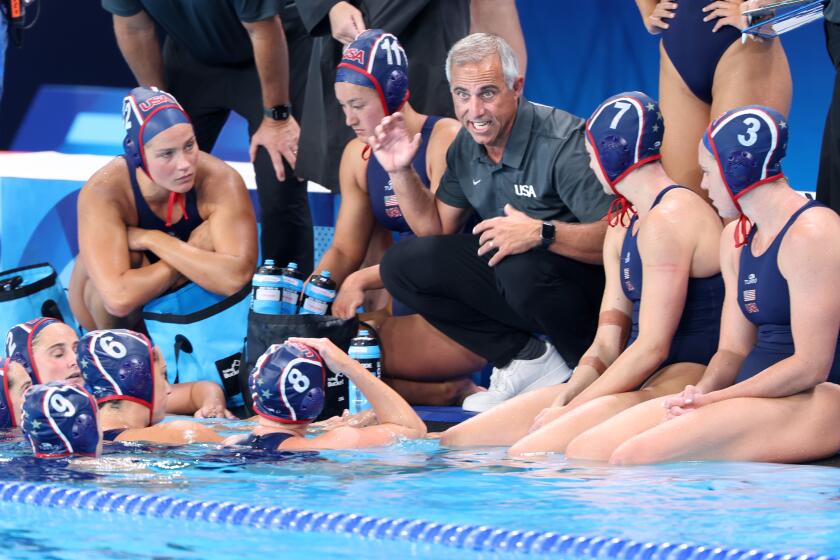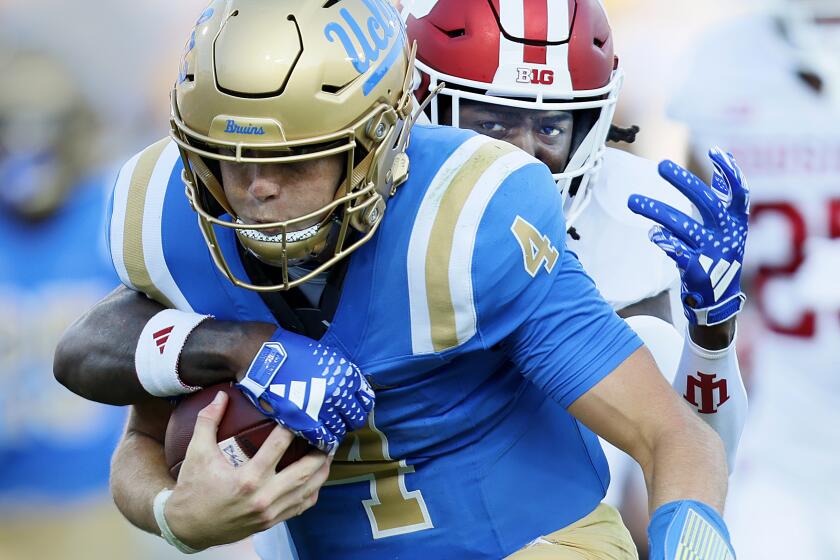Trojans, Bruins face huge obstacles at Ohio State, Tennessee: the noisy stadiums
The heart races. Pupils dilate. Maybe the palms get sweaty.
The natural reaction we have to extreme noise is hard-wired into our human circuitry, a survival instinct that dates back thousands of years.
“Back when we were living in caves, if you heard a loud noise, it was probably a big animal,” said Dr. Alison Grimes, head of the Audiology Clinic at UCLA. “Or the next village coming to raid you.”
And that, by way of extrapolation to modern times, is what the USC and UCLA football players will experience today.
When the Trojans play at Ohio State and the Bruins face Tennessee, they will step inside two of the loudest, most hostile stadiums in college football.
Picture a very large, very angry saber-toothed cat.
“The difference in this game is really the noise,” USC Coach Pete Carroll said. “We have to deal with that really well.”
Which could be easier said than done.
“You can’t simulate 100,000 people,” UCLA defensive end Korey Bosworth explained. “You don’t just hear the noise; you feel it everywhere, in your body, in your head.”
The tall, steep design of Ohio Stadium -- especially in the closed end of the famed “Horseshoe” -- creates open pathways for sound to reach the field level. Similarly, the acoustics at Tennessee’s Neyland Stadium allow for readings well north of 100 decibels.
That’s louder than a jackhammer or a jet taking off across the tarmac. Louder than a marching band or a freight train chugging past.
And when the visitors have the ball, the cacophony will be almost constant. According to Grimes, this heightened stimulus can trigger a number of physiological responses.
“My blood pressure goes up; my heart rate goes up,” the audiologist said. “It’s the old ‘fight or flight’ syndrome.”
The body is preparing for something really bad to happen, a reaction that originates in a part of the brain called the hypothalamus. A warning signal goes out, prompting the release of adrenaline and cortisol.
To some degree, this might benefit athletic performance. Eyes widen and senses sharpen. Blood flow is diverted away from the organs to the major muscle groups, the arms and the legs.
Think about the oft-told story of the mother who lifts a car to get at her child trapped underneath.
If nothing else, a thunderous stadium can get players excited about the game. But that doesn’t erase the negative effects.
Increased blood flow causes the body to heat up, which can lead to those sweaty hands, not so good for quarterbacks and receivers. Clear thoughts are tougher to come by.
“People need to use more mental energy to hear and understand what is being said,” Grimes explained.
Mental energy that a defensive lineman might otherwise devote to reading his keys on an off-tackle run. Mental energy a tailback might need to spot and cut off a blitzing linebacker.
USC center Kristofer O’Dowd recalls a 2007 game at Nebraska when he and his fellow linemen struggled to understand quarterback John David Booty in the huddle.
“John David said a play, passed it to [Chilo] Rachal, passed it to me, I passed it to Jeff [Byers] and he passed it to Sam Baker because we couldn’t hear each other,” he said. “It was like playing ‘telephone.’ ”
Communication becomes even more difficult at the line of scrimmage, where, from a scientific standpoint, the players fight a losing battle.
Sound waves are basically air pressure. When a quarterback tries to yell into the face of a crowd that is sending 110 decibels back at him, it’s like blowing a puff of air into a hurricane wind.
Even more significant, the stadium din covers a wide range of frequencies -- all those different voices and trumpets in the band and feet stamping -- which effectively masks a single voice, said Chris Kyriakakis, a USC associate professor who specializes in audio engineering.
Though Ohio State Coach Jim Tressel made no mention of bandwidths this week, he seems to understand the value of a raucous home crowd.
“We are very proud of our facility, very proud of the atmosphere that is in and around the game,” Tressel said. “So there’s no question about it, the people here are excited.”
Some players insist they can ignore the crowd, but Grimes said research suggests people who believe they have acclimatized to living near airports nonetheless suffer minor sleep disturbances when a plane flies overhead.
“We know that noise does bad things to people,” she said.
Which means the Trojans and Bruins must prepare for the worst today. They have practiced with loudspeakers blaring from the sideline, using hand signals whenever possible.
“We just have to make sure we give them a plan that can be executed without a lot of verbal communication,” UCLA Coach Rick Neuheisel said.
Carroll will follow a similar tack, saying, “At times we’ll miss some stuff. If we do, we do. . . . That’s just how it goes.”
But he points out that perhaps the greatest “noise” play in USC history occurred during the 2005 “Bush Push” game at Notre Dame. Facing fourth and nine with the clock ticking down -- and Irish fans roaring -- quarterback Matt Leinart called an audible and completed a 61-yard pass to receiver Dwayne Jarrett.
O’Dowd was still in high school then, but his subsequent experience with vociferous fans -- Oregon’s Autzen Stadium is a prime example in the Pacific 10 Conference -- has left him wanting more.
Survival instinct notwithstanding, there’s something he likes about an earsplitting evening.
“It’s so loud you feel like your body is vibrating,” the center said. “What’s so surreal about it is that you’re so tuned in to what you’re doing.”
--
Times staff writers Gary Klein and Chris Foster contributed to this report.
Go beyond the scoreboard
Get the latest on L.A.'s teams in the daily Sports Report newsletter.
You may occasionally receive promotional content from the Los Angeles Times.




